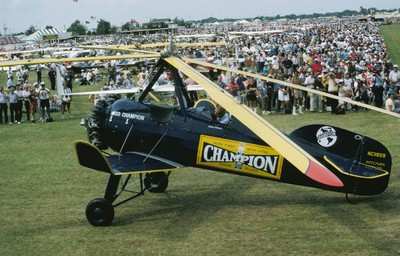Rare Pitcairn Gyro Makes Its Last (?) Flight
The historic Pitcairn PCA-2 Autogyro "Miss Champion" is in its
new home -- the Pitcairn hangar at EAA's Pioneer Airport in
Oshkosh, Wisconsin. Steve Pitcairn had meant to have the historic
aircraft at Oshkosh for Airventure, but family matters prevented
it.

Instead, he had the machine trucked to Oshkosh. He reassembled
it Wednesday morning, and after a test-hop, flew it from Wittman
Regional over to Pioneer Airport.
As these words were being written, he was wrapping up an hour of
display passes for EAA videographers, before Miss Champion goes
into the hangar for good, alongside a Pitcairn PA-7S Sport Mailwing
biplane and a later PA-39 Pitcairn gyro -- both of which were also
donated to the EAA Museum by Steve Pitcairn.
Before there were helicopters, those rotary-winged heroes of the
present hour, there were autogyros. Invented by Spanish
entrepreneur Juan de la Cierva, and licensed in the USA and Japan,
the autogyro solved the problems of rotary-winged flight, becoming
the first truly stall-proof heavier-than-air aircraft. All that was
left was to power the rotors (one of those technical problems
that's really simple to define and really hard to solve).

Autogyros were ubiquitous before World War II. Cierva licensed
his technology to Harold Pitcairn (Steve's father) in the USA, and
to the Kayaba Corporation in Japan, among others. Gyros from
Pitcairn and Kellett in the USA flew airmail from tall buildings,
and landed on the White House lawn (not far from where Marine One
picks up and drops off the President today).
The military was intrigued by their ability to fly extremely
slowly without stalling, to descend vertically over a single point
on the ground, to land with zero rollout and to make a jump
take-off, and considered using them in lieu of light liaison and
artillery-spotting planes.
"The Autogiro could clear a 15-meter (50-foot) obstacle from a
dead stop in only 76 meters (250 feet) of horizontal travel - a
feat unmatched by any airplane of the time," the Smithsonian
National Air and Space Museum notes.
During the war, the Japanese flew gyros on antisubmarine patrol
(and built the only gyroplane carrier in naval history), the
Germans used a gyro-kite as a lookout "tower" for surfaced
submarines, and the British flew PA-39 gyroplanes on the mundane
but vital wartime task of radar calibration.

After helicopters were developed, gyroplane development lay
fallow until the 1950s, when Dr Igor Bensen developed lightweight,
inexpensive gyros based on the technology of the wartime German
gyro-kite. Many experimental, ultralight and light-sport gyroplanes
today owe their existence to Dr Bensen's example, but the
tube-frame tractor configuration of the Cierva gyro and its
licensees is making a comeback.
But all rotorcraft today are the descendants of Cierva's first
autogyro -- and Miss Champion, while a successful aircraft in her
own right, is significant because of her closeness to the initial
creation of successful rotorcraft -- you might say, Eve to Cierva's
gyro's Adam, and you wouldn't be too far off the mark.
Miss Champion's designation -- PCA-2 -- stands for
Pitcairn-Cierva Autogyro, Model 2. A Pitcairn PCA-1A, the oldest
surviving US-built gyro can be seen at the National Air and Space
Museum, as can the first gyro to fly in the USA, the Cierva C.8W.
But while Miss Champion may be destined for static display, the
friendly, accessible atmosphere of Pioneer Airport is a far cry
from the NASM's facility on the Mall or its Udvar-Hazy Center at
Dulles, where historic aircraft are stuffed and mounted like
big-game trophies.
 ANN's Daily Aero-Term (04.24.24): Runway Lead-in Light System
ANN's Daily Aero-Term (04.24.24): Runway Lead-in Light System ANN's Daily Aero-Linx (04.24.24)
ANN's Daily Aero-Linx (04.24.24) Aero-FAQ: Dave Juwel's Aviation Marketing Stories -- ITBOA BNITBOB
Aero-FAQ: Dave Juwel's Aviation Marketing Stories -- ITBOA BNITBOB Classic Aero-TV: Best Seat in The House -- 'Inside' The AeroShell Aerobatic Team
Classic Aero-TV: Best Seat in The House -- 'Inside' The AeroShell Aerobatic Team Airborne Affordable Flyers 04.18.24: CarbonCub UL, Fisher, Affordable Flyer Expo
Airborne Affordable Flyers 04.18.24: CarbonCub UL, Fisher, Affordable Flyer Expo





